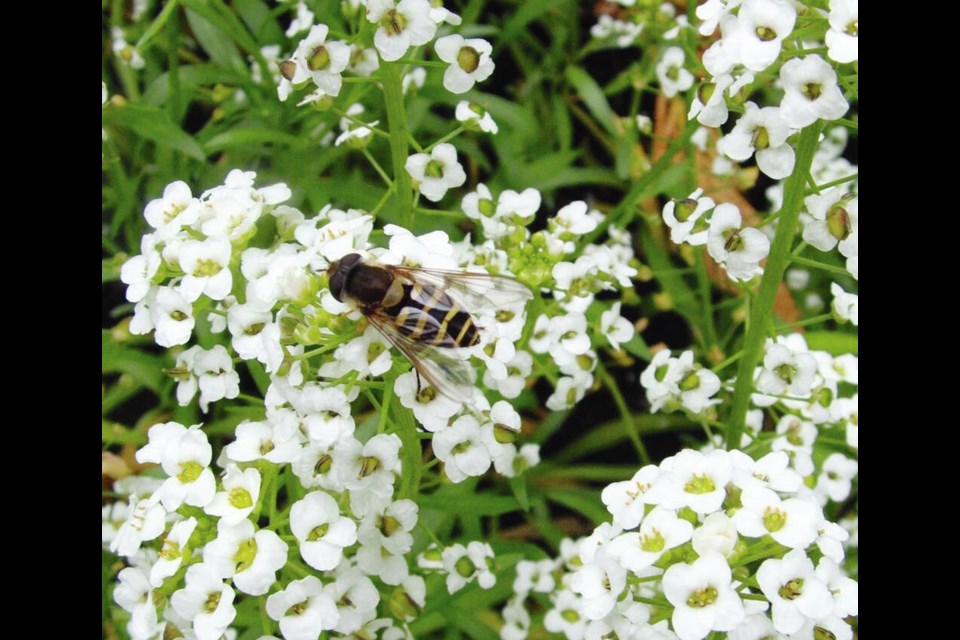On the morning after the election, I ambled up the gentle incline into the back garden, with the intent of capturing a decent photo of the imposing shoo-fly (Nicandra) plants that had volunteered their presence in two of the vegetable plots.
A sound cautioned me to stop. Was that a swarm of wasps causing the communal buzzing I heard?
Not wasps, but dozens of hover flies busy in the billowing mounds of white sweet alyssum edging the path I stood on. I moved to another, nearby path also edged with alyssum and observed the same activity. The only other times I’ve seen such high numbers of the flies together is in blooming cilantro and parsley.
The adult flies look like miniature wasps. I’m always pleased to see them in the garden. Adults emerge very early in the spring, to mate and lay eggs wherever they find aphids for the emerging hover fly larvae to feed on. After feeding for two to three weeks the larvae go to ground to pupate. Following pupation, more adults emerge. The process repeats itself through spring, summer and fall to produce at least four generations of the helpful flies and their aphid-devouring larvae, until they overwinter in garden litter as either larvae or adult flies.
Showy “shoo-fly” plants. In the early days of this garden, I began delving with enthusiasm into growing unfamiliar plants that seemed unusual and interesting, ones I found in catalogue listings.
That’s how I came across “Shoo Fly Plant” (Nicandra physalodes), an old-fashioned annual flower that grows into sturdy, bushy plants with sky-blue, bell-shaped summer flowers followed by attractive papery pods.
I liked the first plants well enough to expand into “Nigra,” a form with purple-black stems and purple-flushed pods. Nigra is the one most prominent among the plants that have self-sown in the garden each year. Another form with white and green leaves gradually faded out of the garden.
Some of this year’s plants are as tall as I am, with wide-stretching arms now, at the end of the season, bearing mostly big, purplish pods. A few remaining blooms attract crowds of hover flies.
Salt Spring Seeds lists the variegated form of Shoo Fly Plant — “Splash of Cream,” a 90 to 120 cm tall plant with purple stems and creamy white and green leaves.
Fruit fly feedback. In response to a recent column’s comments on dealing with fruit flies in the kitchen, Mark and Pauline wrote: “Our small, hand-held vacuum works well in swooping up the flies.”
Vacuuming helps to deal with whiteflies too, but in both cases it is necessary to sneak up on the flies, and open the vacuum’s bleeder valve to avoid sucking up various nearby items along with the flies.
Paula puts four cm of apple cider vinegar with a drop or two of dish soap into a small jam jar (the kind used for home canning) and secures plastic wrap over the opening with the jar’s metal collar.
“I poke holes in the wrap with a toothpick. It has worked incredibly well. In the first two days I caught over 50 flies. I renew the trap every few days. Bonus: the vinegar has a pleasant scent, and is inexpensive.”
Why didn’t I think of that? The apple cider vinegar traps I put out in the strawberries and raspberries to attract spotted wing Drosophila (SWD, a different kind of fruit fly that targets berries and soft fruits) work just as Paula describes. Apple cider vinegar has been found to be the most effective SWD attractant.
For an outdoor trap, I use a sour cream or similar carton with holes punched into it, just below the rim. The vinegar trap is covered, and placed among target plants.
SWD flies continue mating in the fall. Most survive the cold of winter as adult females, carrying eggs, tucked into garden litter.
VHS meeting. The Victoria Horticultural Society is hosting a Zoom meeting on Tuesday, 7 to 8:30 p.m. Brian Minter, well known author and gardening expert on radio and tv, will speak about Significant Changes in the Past One Hundred Years of Gardening and What the Future Holds. A pre-meeting workshop at 6:30 will deal with alternatives to rodenticides for vermin control. Drop-in fee for non-members is $5. To register, visit vichortsociety.org.


